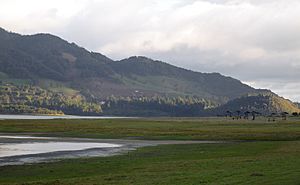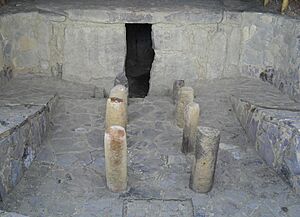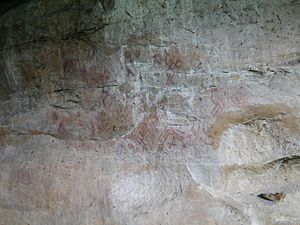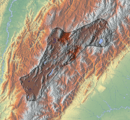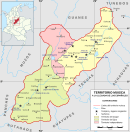Herrera Period facts for kids
The Herrera Period was an important time in the history of Colombia. It happened before the Muisca people lived in the area. The Muisca were a group who lived in the Altiplano Cundiboyacense before the Spanish arrived.
This period is usually thought to have lasted from about 800 BCE to 800 CE. Some experts even think it started as early as 1500 BCE. We know a lot about the Herrera Period thanks to many archaeologists. Some of the main researchers include Ana María Groot, Gonzalo Correal Urrego, Thomas van der Hammen, Carl Henrik Langebaek Rueda, Sylvia M. Broadbent, and Marianne Cardale de Schrimpff.
Contents
Where the Name Comes From
The Herrera Period gets its name from Lake Herrera (Laguna de la Herrera). This is where archaeologist Silvia Broadbent first started digging and found evidence of this period in 1971.
Lake Herrera is one of the last parts of a much bigger, ancient lake called Lake Humboldt. This huge lake existed during the Pleistocene (Ice Age) on the Bogotá savanna. Today, Lake Herrera is about 280 hectares (almost 700 acres) big. It sits at an altitude of 2,550 meters (about 8,366 feet). You can find it near the towns of Mosquera, Madrid, and Bojacá in the Cundinamarca region. The archaeological site of Aguazuque is also close by.
What Life Was Like
The high plains of central Colombia, known as the Altiplano Cundiboyacense, have been home to people for a very long time. The earliest signs of people, like stone tools, are from about 12,400 years ago. These tools were found at places like El Abra and Tequendama. This early time, when people mostly used stone tools, lasted until about 1000 BCE. Other old sites include Aguazuque and Checua.
People started farming about 5,000 years ago. This led to groups of people living together in more organized ways. The Herrera Period is one of these early organized societies in the Andes. Some of the oldest evidence of people living in one place is from Zipacón, dating back to 3270 BCE.
During the Herrera Period, people also started making and using ceramic pottery. The oldest pieces of pottery found are from about 500 BCE. However, one very old piece was found near Tocarema, dating back to 750 BCE.
The people of the Herrera Period were farmers. We know this from findings in places like the Thomas van der Hammen Reserve. This reserve is named after the Dutch geologist and botanist Thomas van der Hammen, who studied the area.
Places Where We Found Evidence
Archaeologists have found many signs of the Herrera Period across the Altiplano Cundiboyacense. Some of these important places include Sopó, Soacha, Usme, Iza, Gámeza, Facatativá (Piedras del Tunjo Archaeological Park), Moniquirá (El Infiernito), Chía, Chita, Chiscas, Soatá, Jericó, Sativasur, Covarachía, Sativanorte, and El Cocuy.
The site in Soacha is especially important. Finds there date from 400 BCE and continue into the time of the Muisca people. At this site, archaeologists found the remains of 2,200 people. They also found 274 complete ceramic pots and many stone tools. Seeds of cotton, maize (corn), beans, and curuba were also discovered. In addition, 634 broken and whole spindles (tools for spinning thread) and 100 tunjos (small figures, not used for offerings) were found in Soacha.
How We Understand the Timeline
| Timeline of inhabitation of the Altiplano Cundiboyacense, Colombia | |
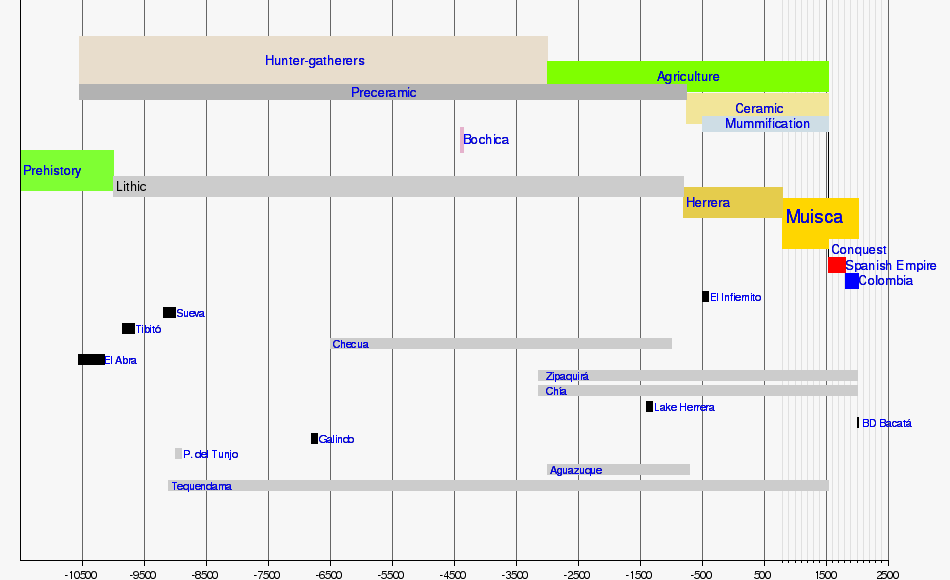 |
|
Over time, as new discoveries are made, different experts have suggested slightly different ways to divide the Herrera and Muisca periods. There are also some differences depending on the specific region. The tables below show how different archaeologists have classified these time periods.
| Author | Name | Start age | End age | Notes |
|---|---|---|---|---|
| Romano, 2003 | Early Herrera | 900 BCE | 0 | |
| Late Herrera | 0 | 700 | ||
| Early Muisca | 700 | 1100 | ||
| Late Muisca | 1100 | 1600 | ||
| Kruschek, 2003 | Herrera | 800 BCE | 800 | |
| Early Muisca | 800 | 1200 | ||
| Late Muisca | 1200 | 1600 | ||
| Boada, 2003 | Herrera | 300 BCE | 200 | |
| Early Muisca | 200 | 1000 | ||
| Late Muisca | 1000 | 1600 | ||
| Cárdenas & Kleef, 1996 | Herrera | 1500 BCE | 800 | |
| Muisca | 800 | 1600 | ||
| Peña, 1991 | Early Herrera | 14th century BCE | 4th century BCE | |
| Middle Herrera | 4th century BCE | 1st century CE | ||
| Late Herrera | 6th century CE | 10th century CE | ||
| Early Muisca | ||||
| Late Muisca | ||||
| Langebaek, 1986 | Herrera | |||
| Muisca | ||||
| Modern | ||||
| Schrimpff, 1981 | Herrera | 400 BCE | 200 | |
| Muisca | 1400 | 1500 | ||
Regional Differences
Western Slopes of the Eastern Ranges
| Author | Name | Start age | End age | Notes |
|---|---|---|---|---|
| Argüello, 2004 | Herrera | 800 BCE | 800 | |
| Pubenza | 800 | 1000 | ||
| Late Period | 1000 | 1550 | ||
| Modern | >1550 | |||
| Schrimpff, 1976 | Period I | 750 | 1200 | |
| Period II | 1200 | 1550 | ||
Boyacá Region
| Author | Name | Start age | End age | Notes |
|---|---|---|---|---|
| Langebaek, 2001 | Herrera | 400 BCE | 700 | |
| Late Herrera | 700 | 1000 | ||
| Early Muisca | 1000 | 1200 | ||
| Late Muisca | 1200 | 1600 | ||
| Modern | >1600 | |||
| Boada, 2007 | Late Herrera | 700 | 1000 | |
| Early Muisca | 1000 | 1300 | ||
| Late Muisca | 1300 | 1600 | ||
See also
 In Spanish: Cultura Herrera para niños
In Spanish: Cultura Herrera para niños


